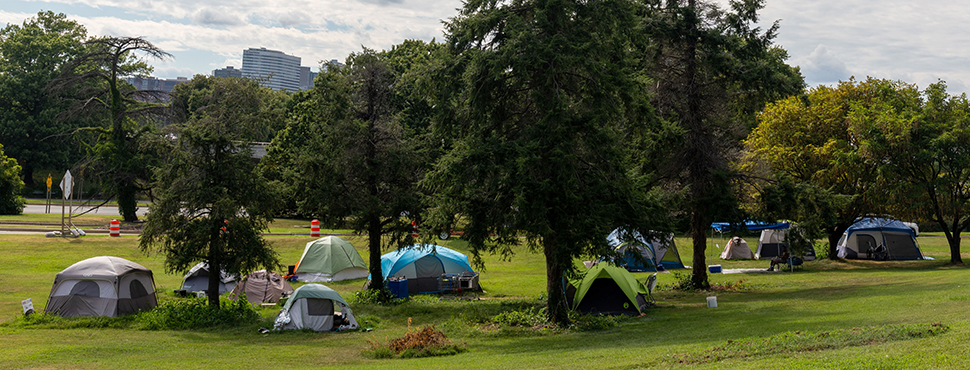Federal Impacts
Executive Order to Overhaul Federal Homelessness Policy

A new Trump administration Executive Order (EO), "Ending Crime and Disorder on America's Streets," may prompt significant shifts in federal policy on tackling homelessness. The EO intends to move federal agencies and the programs they administer away from a "Housing First" model that prioritizes permanent housing and voluntary services. In its place, the EO focuses on conditioning housing aid on behavioral treatment.
Federal Shifts in Tackling Homelessness
The move comes as part of a broad Trump administration initiative on crime and immigration enforcement. The action also follows last year's U.S. Supreme Court decision in City of Grants Pass v. Johnson, upholding the authority of local governments to enforce ordinances banning public camping and sleeping, even when individuals lack access to shelter. Estimates are that encampment bans are in place in more than 100 cities.
Regulatory Changes Ahead
The new EO is likely to prompt regulatory changes from the Departments of Housing and Urban Development (HUD), Health and Human Services (HHS), and Justice (DOJ) related to existing programs and funding related to homelessness. The changes have the potential to reshape how aid is delivered and who is eligible.
The EO directs HUD and HHS to:
- Revise regulations, requirements, and guidance to end support for Housing First policies.
- Ensure federal housing programs require, where possible, active participation in treatment for substance use disorders or severe mental illness.
- Prioritize discretionary funding for jurisdictions that enforce bans on urban camping, loitering, squatting, and open-air drug use.
DOJ is directed to:
- Seek reversal of judicial precedents and consent decrees that limit civil commitment.
- Support states in adopting more flexible commitment and treatment laws.
- Assess whether federally funded organizations that operate safe consumption sites, distribute drug paraphernalia, or allow on-site illicit drug use are violating federal law, and initiate enforcement actions where applicable.
Push Back Expected
Implementation challenges are expected. Civil commitment procedures are generally governed by state law, limiting the DOJ's direct reach, and conditions on housing assistance could face fair housing litigation.
The changes called for in the EO could also have impacts on the need for inpatient treatment facilities. However, agencies maintain broad discretion over program rules and could use regulatory changes to drive local compliance, especially as funding needs to tackle the increasing challenge.
Looking Ahead for Local Governance and Planning
Homelessness has increasingly become a flashpoint issue in local governance. The 2024 HUD "Point in Time" count showed the largest annual increase on record, up 18 percent over 2023.
5 Meaningful Ways To Support the Unhoused
Through targeted investments in small-scale programs, communities can make a difference in the quality of life for people experiencing homelessness.
Here are 5 meaningful ways to support the unhoused, from a planner who has experienced homelessness and seen firsthand how planners can help.
While the Trump administration has proposed policy changes, Congress has thus far proven reluctant to agree to significant funding cuts. Although final action still awaits, the House and Senate versions of HUD funding bills for FY26 retain critical funding for homelessness programs.
With the EO now in place, planners should expect agencies to begin the process of rewriting program requirements. New policies could be in place in time for the next round of federal grants. Meanwhile, Congress continues work on finalizing a funding agreement, facing a September 30 deadline for action.
The Role of Housing Supply
The EO posits a range of behavioral causes of homelessness; however, other studies suggest that the lack of housing options is also a major culprit. Researchers at Pew found that metro areas where the median rent exceeds one-third of the median monthly income report much higher rates of homelessness.
While the federal approach to homelessness fluctuates, planners at the local level will continue to update and reform regulations that stand in the way of producing more housing supply — an essential component of long-term solutions for the growing homelessness crisis.
Housing Supply Accelerator Playbook

Diversifying Resources and strategies to increase housing supply
Learn more about strategies, solutions, and case studies for increasing housing supply through local, state, and federal resources in your community by downloading the Housing Supply Accelerator Playbook.
Top image: Alex Kent/The New York Times
ABOUT THE AUTHOR


